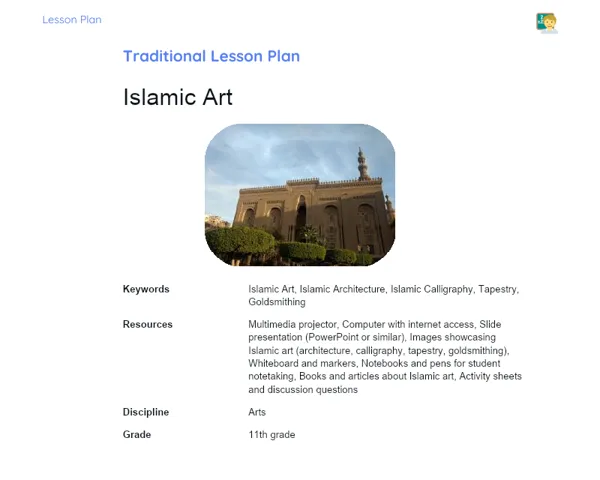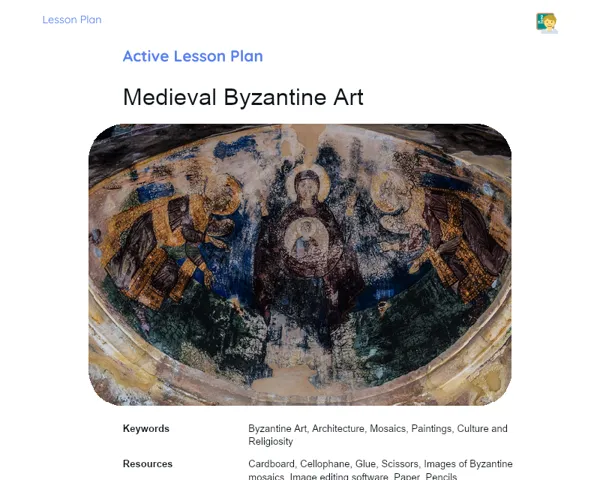Lesson Plan | Lesson Plan Tradisional | Sound Improvisation
| Keywords | Musical improvisation, Sound creativity, Improvised vs rehearsed sounds, Improvisation techniques, Sound experimentation, Personal expression, Jazz, Rock, Louis Armstrong, Jimi Hendrix |
| Resources | Various musical instruments (e.g., drums, flutes, guitars), Unconventional instruments (e.g., pots, bottles, boxes), Whiteboard and markers, Sound system or computer with speakers, Recordings of performances by Louis Armstrong and Jimi Hendrix, Paper and pencil for notes |
Objectives
Duration: (10 - 15 minutes)
The aim of this stage is to introduce learners to the concept of sound improvisation in music, highlighting the importance of creativity and sound experimentation. Furthermore, it seeks to clarify the differences between improvised sounds and those that are meticulously rehearsed, getting learners ready for the practical exercises planned for the lesson.
Objectives Utama:
1. Discuss the concept of sound improvisation in music.
2. Show the difference between improvised and rehearsed sounds.
3. Foster creativity and sound experimentation among learners.
Introduction
Duration: (10 - 15 minutes)
The purpose of this stage is to introduce learners to the concept of sound improvisation in music, focusing on the significance of creativity and sound experimentation. It aims to clarify the differences between improvised sounds and those that have been thoroughly rehearsed, preparing learners for the practical tasks that will follow in the lesson.
Did you know?
Did you know that many iconic musicians, such as Louis Armstrong in jazz or Jimi Hendrix in rock, were masters of improvisation? They could whip up incredible music right on the spot, without any rehearsal beforehand. What's more, improvisation isn’t solely for music; it features in theatre, dance, and even in our daily lives, such as when we whip up a quick fix for an unexpected issue.
Contextualization
To kick off the lesson on sound improvisation, it’s essential to give learners some background on what improvisation entails. Start by explaining that improvisation involves creating something fresh and unique spontaneously, without any prior preparation. In musical terms, this means conjuring melodies, rhythms, or harmonies on the fly, without adhering to sheet music or a specific blueprint. Improvisation is a valuable skill across various forms of art and can be a thrilling avenue for exploring creativity. Connect this to everyday circumstances where learners might have improvised, like telling a story on the spot or dreaming up a new game with mates.
Concepts
Duration: (35 - 45 minutes)
The purpose of this stage is to further learners’ understanding of sound improvisation by providing detailed examples that underscore the importance and techniques of this musical practice. It also aims to spark learners' creativity and encourage them to experiment and compare improvised sounds with rehearsed ones, setting the stage for future practical activities.
Relevant Topics
1. Concept of Musical Improvisation: Clarify that musical improvisation involves the spontaneous creation of music, without following a score or any predetermined plan. Emphasise that improvisation allows musicians to express their feelings and creativity in a distinctive manner.
2. Importance of Improvisation: Share how improvisation features in various musical genres, such as jazz, rock, and classical. Illustrate that legendary musicians like Louis Armstrong and Jimi Hendrix utilised improvisation to craft unforgettable performances.
3. Difference Between Improvised and Rehearsed Sounds: Contrast sounds that are created on the spot (improvised) with those that are prepared and rehearsed. Offer practical examples showing how improvisation can bring an exciting new dynamic to music.
4. Basic Improvisation Techniques: Introduce some simple techniques that learners can use to improvise, like repeating musical phrases, varying rhythms, and trying out different tonalities and dynamics.
5. Sound Experimentation: Encourage learners to explore various sounds and instruments, including unconventional ones, to create new soundscapes. Explain that experimentation is a crucial component of improvisation.
To Reinforce Learning
1. What is the main difference between an improvised sound and a rehearsed sound?
2. Name a well-known musician who utilised improvisation in their performances and explain how they did so.
3. How can improvisation enhance creativity and personal expression in music?
Feedback
Duration: (20 - 25 minutes)
The aim of this stage is to review and reinforce the knowledge that learners have gained during the lesson, promoting lively discussion that solidifies the concepts of musical improvisation, stimulates reflection on creativity and personal expression within music, and encourages learners to share their thoughts and experiences. This segment also seeks to address any uncertainties that may have arisen and guarantee that all learners have a comprehensive understanding of the content covered.
Diskusi Concepts
1. What is the main difference between an improvised sound and a rehearsed sound? The key difference is that an improvised sound is created spontaneously, without prior preparation, which allows for instant and organic expression. In contrast, a rehearsed sound is meticulously crafted and practised before a performance, adhering to a score or specific outline. This means that the rehearsed sound tends to be more predictable and controlled, while the improvised sound is freer and open to spontaneous variations. 2. Name a famous musician who used improvisation in their performances and explain how they did so. A classic example would be Louis Armstrong, widely hailed as a jazz legend. Armstrong was renowned for his remarkable ability to improvise trumpet solos that were innovative and electrifying. He fluidly created unique melodies in the heat of the moment, without following a score. Another notable figure is Jimi Hendrix, a rock guitarist who frequently improvised during his shows, producing unpredictable and exhilarating guitar solos. 3. How can improvisation influence creativity and personal expression in music? Improvisation enables musicians to explore their creativity more freely, unmuffled by the constraints of formal sheet music or rigid plans. This paves the way for personal expression, allowing songwriters to weave their emotions, experiences, and feelings into the music they are producing at that very moment. Additionally, improvisation can lead to fresh musical discoveries, encouraging artists to experiment with different rhythms, melodies, and harmonies, thereby broadening their skills and repertoire.
Engaging Students
1. Do you think it’s easier or harder to create music on the go, without any prep? Why? 2. Can you recall a time in your life when you had to improvise? How did that feel? Was it a breeze or a challenge? 3. If you were a legendary musician like Louis Armstrong or Jimi Hendrix, what would you want to improvise in your gigs? Why? 4. In your opinion, how do you think improvisation could help hone musical skills and problem-solving abilities? 5. Do you prefer listening to a neatly rehearsed song or one that involves improvisation? Share your preference.
Conclusion
Duration: (10 - 15 minutes)
The aim of this lesson plan phase is to review and consolidate the main points covered, ensuring learners have a solid and thorough grasp of the discussed topic. Moreover, this section aims to bridge theory with practical application and highlight the significance of the subject in learners' everyday lives, fostering a final reflection on the importance of musical improvisation.
Summary
['Concept of musical improvisation: spontaneous creation of music without following a score or a set plan.', 'Importance of improvisation across various musical genres, such as jazz and rock.', 'Difference between improvised sounds (spontaneously created) and rehearsed sounds (prepared in advance).', 'Basic improvisation techniques: repetition of musical phrases, rhythm variation, and tonal experimentation.', 'Exploring different sounds and instruments to craft new sonic landscapes.']
Connection
The lesson linked theory to practice by explaining improvisation concepts and demonstrating, through examples of iconic musicians and practical activities, how improvisation can be employed in music. Learners were encouraged to experiment and compare improvisations with rehearsed pieces, facilitating a practical understanding of the theoretical content addressed.
Theme Relevance
This subject matter is pertinent to everyday life as improvisation is a valuable skill extending beyond music; it's equally vital in theatre, dance, and in our daily situations requiring creativity and quick thinking. Improvisation promotes personal expression and creativity, equipping learners with new skills and perspectives.


